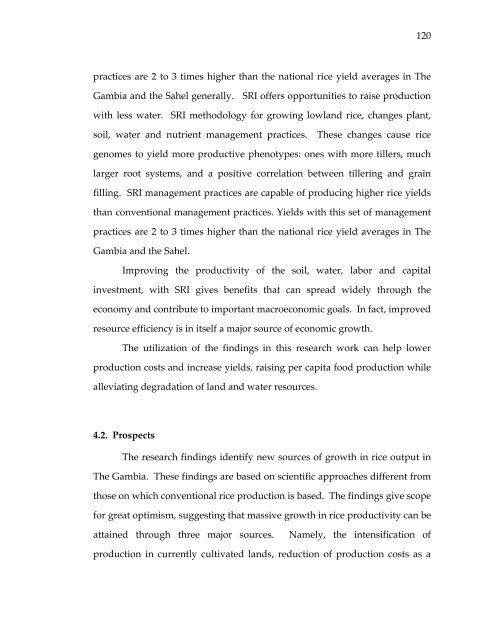Management of rice production systems to increase productivity
Management of rice production systems to increase productivity
Management of rice production systems to increase productivity
Create successful ePaper yourself
Turn your PDF publications into a flip-book with our unique Google optimized e-Paper software.
practices are 2 <strong>to</strong> 3 times higher than the national <strong>rice</strong> yield averages in The<br />
Gambia and the Sahel generally. SRI <strong>of</strong>fers opportunities <strong>to</strong> raise <strong>production</strong><br />
with less water. SRI methodology for growing lowland <strong>rice</strong>, changes plant,<br />
soil, water and nutrient management practices. These changes cause <strong>rice</strong><br />
genomes <strong>to</strong> yield more productive phenotypes: ones with more tillers, much<br />
larger root <strong>systems</strong>, and a positive correlation between tillering and grain<br />
filling. SRI management practices are capable <strong>of</strong> producing higher <strong>rice</strong> yields<br />
than conventional management practices. Yields with this set <strong>of</strong> management<br />
practices are 2 <strong>to</strong> 3 times higher than the national <strong>rice</strong> yield averages in The<br />
Gambia and the Sahel.<br />
120<br />
Improving the <strong>productivity</strong> <strong>of</strong> the soil, water, labor and capital<br />
investment, with SRI gives benefits that can spread widely through the<br />
economy and contribute <strong>to</strong> important macroeconomic goals. In fact, improved<br />
resource efficiency is in itself a major source <strong>of</strong> economic growth.<br />
The utilization <strong>of</strong> the findings in this research work can help lower<br />
<strong>production</strong> costs and <strong>increase</strong> yields, raising per capita food <strong>production</strong> while<br />
alleviating degradation <strong>of</strong> land and water resources.<br />
4.2. Prospects<br />
The research findings identify new sources <strong>of</strong> growth in <strong>rice</strong> output in<br />
The Gambia. These findings are based on scientific approaches different from<br />
those on which conventional <strong>rice</strong> <strong>production</strong> is based. The findings give scope<br />
for great optimism, suggesting that massive growth in <strong>rice</strong> <strong>productivity</strong> can be<br />
attained through three major sources. Namely, the intensification <strong>of</strong><br />
<strong>production</strong> in currently cultivated lands, reduction <strong>of</strong> <strong>production</strong> costs as a
















